Interaction and Communication between Programs
System-Level I/O
Input and Output(IO) is the process of copying data between main memory and external devices such as disk drives, terminals, and networks.
- Input copy data from devices to main memory
- Output copy data from memory to devices
Most of the time, the higher-level I/O functions work quite well and there is no need to use Unix I/O directly. So why bother learning about Unix I/O?
- Understanding Unix I/O will help you understand other systems concepts
- Sometimes you have no choice but to use Unix I/O
10.1 Unix I/O
A Linux file is a sequence of m bytes: {B1 , B2 , B3 , …., Bm-1}
All I/O devices, such as networks, disks, and terminals, are modeled as files, and all input and output is performed by reading and writing the appropriate files.
This elegant mapping of devices to files allows the Linux kernel to export a simple, lowlevel application interface, known as Unix I/O, that enables all input and output to be performed in a uniform and consistent way:
Opening files
An application announces its intention to access an I/O device by asking the kernel to open the corresponding file.
The kernel returns a small nonnegative integer, called a descriptor, that identifies the file in all subsequent operations on the file.
The kernel keeps track of all information about the open file. The application only keeps track of the descriptor.
Each process created by a Linux shell begins life with three open files
stdin : 0 , stdout : 1 , stderr : 2
Changing the current file position
- The kernel maintains a file position k, initially 0, for each open file.
- The file position is a byte offset from the beginning of a file. An application can set the current file position k explicitly by performing a
seekoperation.
Reading and Writing files
- A read operation copies n > 0 bytes from a file to memory, starting at the current file position k and then incrementing k by n.
- Given a file with a size of m bytes, performing a read operation when k ≥ m triggers a condition known as end-of-file (EOF), which can be detected by the application. There is no explicit “EOF character” at the end of a file.
Closing files
- When an application has finished accessing a file, it informs the kernel by asking it to close the file.
- The kernel responds by freeing the data structures it created when the file was opened and restoring the descriptor to a pool of available descriptors
10.2 Files
Each Linux file has a type that indicates its role in the system
- A regular file contains arbitrary data.
- A directory is a file consisting of an array of links, where each link maps a filename to a file, which may be another directory
- A socket is a file that is used to communicate with another process across a network
Other file types include named pipes, symbolic links, and character and block devices….
- The Linux kernel organizes all files in a single directory hierarchy anchored by the root directory named
/(slash).
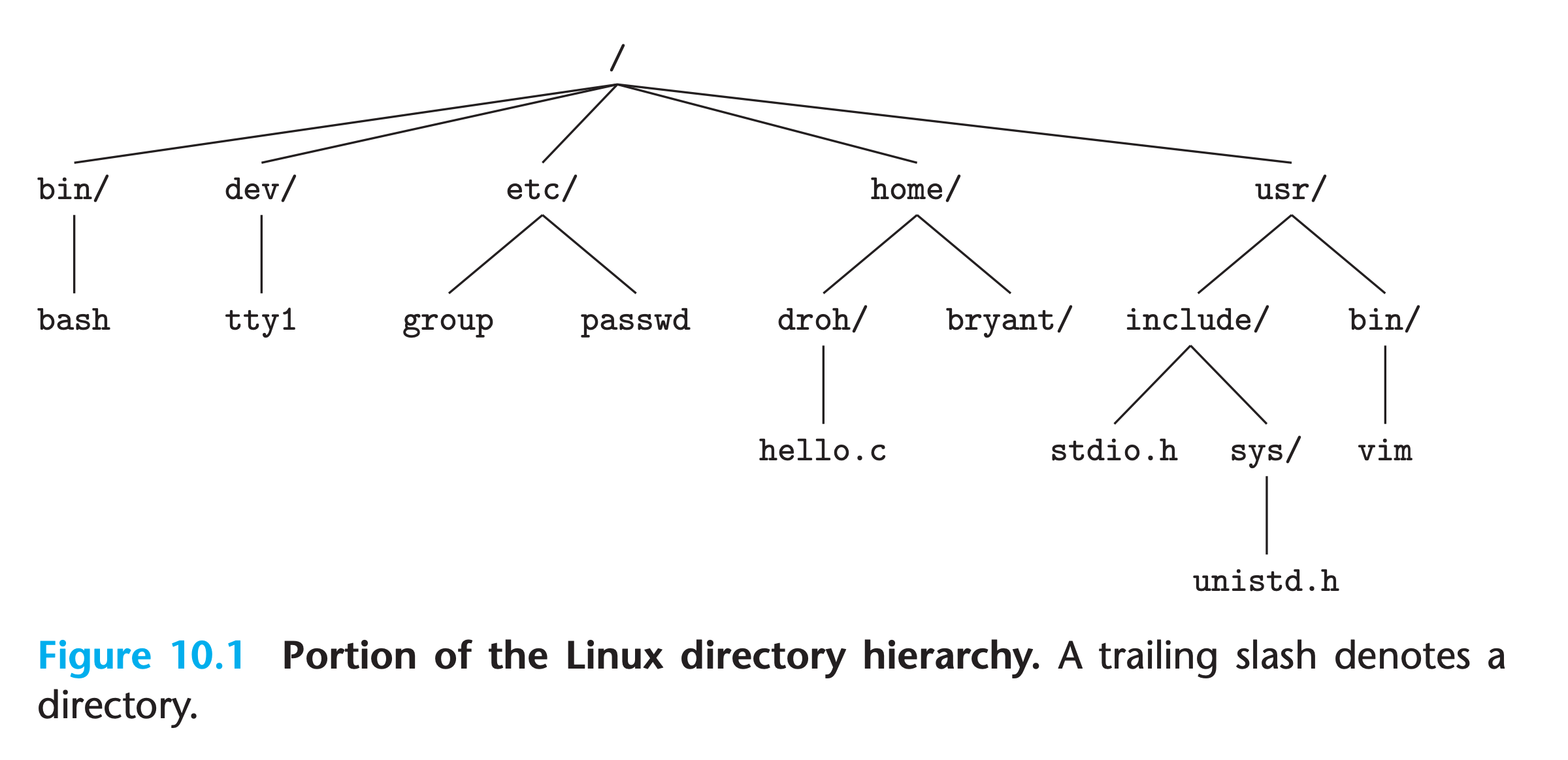
- As part of its context, each process has a current working directory that identifies its current location in the directory hierarchy.
- Pathnames can be either absolute or relative.
10.3 Opening and Closing Files
A process opens an existing file or creates a new file by calling the open function
1 |
|
The
openfunction converts afilenameto afile descriptorand returns the descriptor number.(The descriptor returned is always the smallest descriptor that is not currently open in the process.)
The flags argument indicates how the process intends to access the file
(Read-Only, Write-Only, R&W)
The flags argument can also be ored with one or more bit masks that provide additional instructions for writing(Create, Truncate, Append)
The
modeargument specifies the access permission bits of new files.
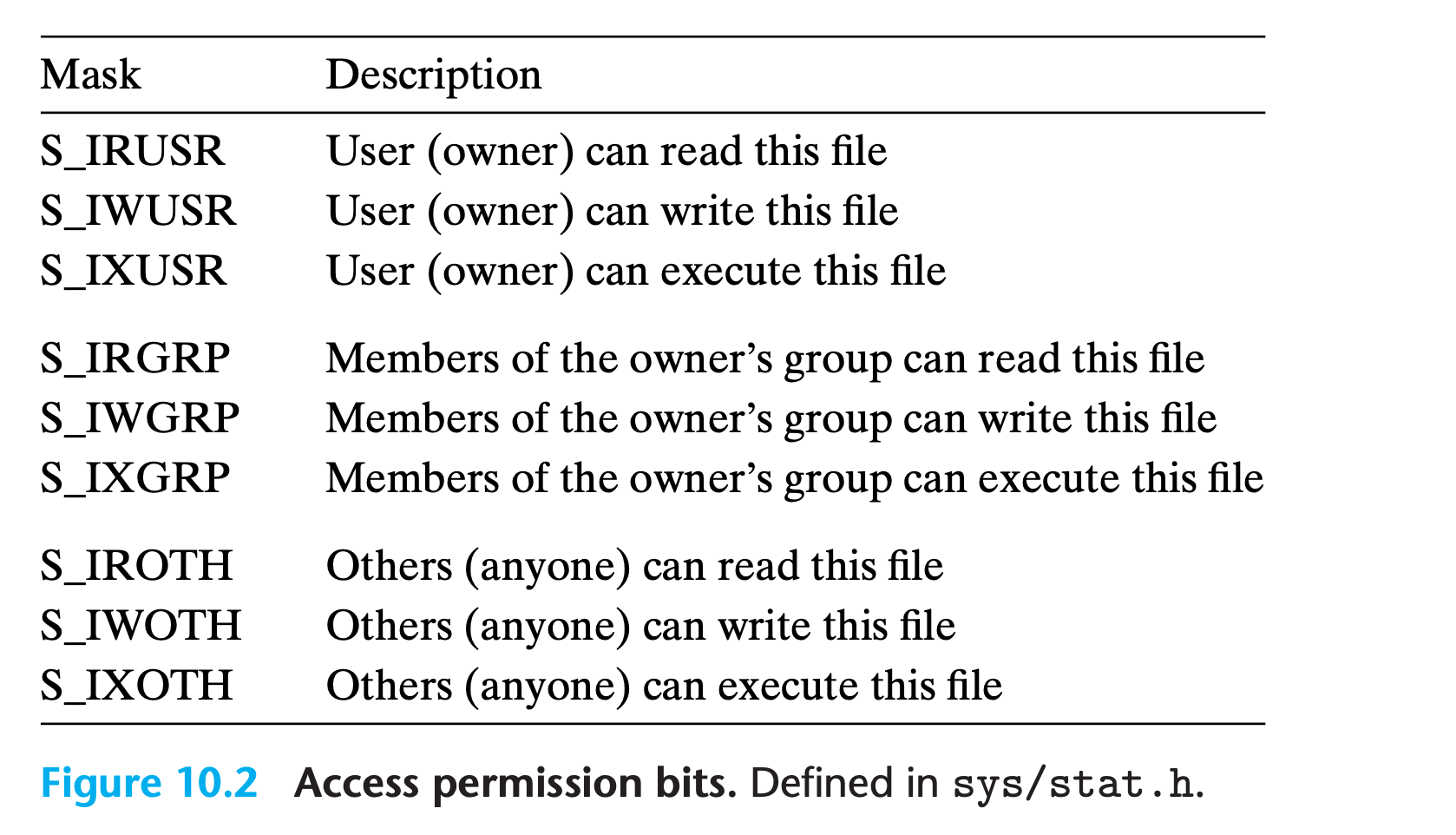
Finally, a process closes an open file by calling the close function.
1 |
|
Closing a descriptor that is already closed is an error.
Practice Problem 10.1
What’t the output of the following code
2
3
4
5
6
7
8
9
10
11
12
13
14
15
int main() {
int fd1, fd2;
fd1 = open("foo.txt", O_RDONLY, 0);
close(fd1);
fd2 = open("baz.txt", O_RDONLY, 0);
printf("fd2 = %d\n", fd2);
exit(0);
}
Verification:
The descriptor returned is always the smallest descriptor that is not currently open in the process
Since 0,1,2 is already used, the output will 3.
1 | $ touch baz.txt |
10.4 Reading and Writing Files
1 |
|
The
readfunction copies at most n bytes from the current file position of descriptor fd to memory locationbufThe
writefunction copies at most n bytes from memory locationbufto the current file position of descriptorfdApplications can explicitly modify the current file position by calling the
lseekfunctionIn some situations, read and write transfer fewer bytes than the application requests
- Encountering EOF on reads.
- Reading text lines from a terminal.
- Reading and writing network sockets
So if you want to build robust (reliable) network applications such as Web servers, then you must deal with short counts by repeatedly calling read and write until all requested bytes have been transferred.
What’s the difference between ssize_t and size_t?
On x86-64 systems, a size_t is defined as an unsigned long, and an ssize_t (signed size) is defined as a long. The read function returns a signed size rather than an unsigned size because it must return a −1 on error.
10.5 Robust Reading and Writing with the Rio Package
In this section, we will develop an I/O package, called the Rio (Robust I/O) package, that handles these short counts for you automatically.
Rio provides two different kinds of functions
- Unbuffered input and output functions.
- These functions transfer data directly between memory and a file, with no application-level buffering
- Buffered input functions
10.5.1 Rio Unbuffered Input and Output Functions
1 | //Returns: number of bytes transferred if OK, 0 on EOF (rio_readn only), −1 on error |
10.5.2 Rio Buffered Input Functions
system level I/O operations are expensive, so we reduce the amount we call them by adding a buffer between user code and I/O operation
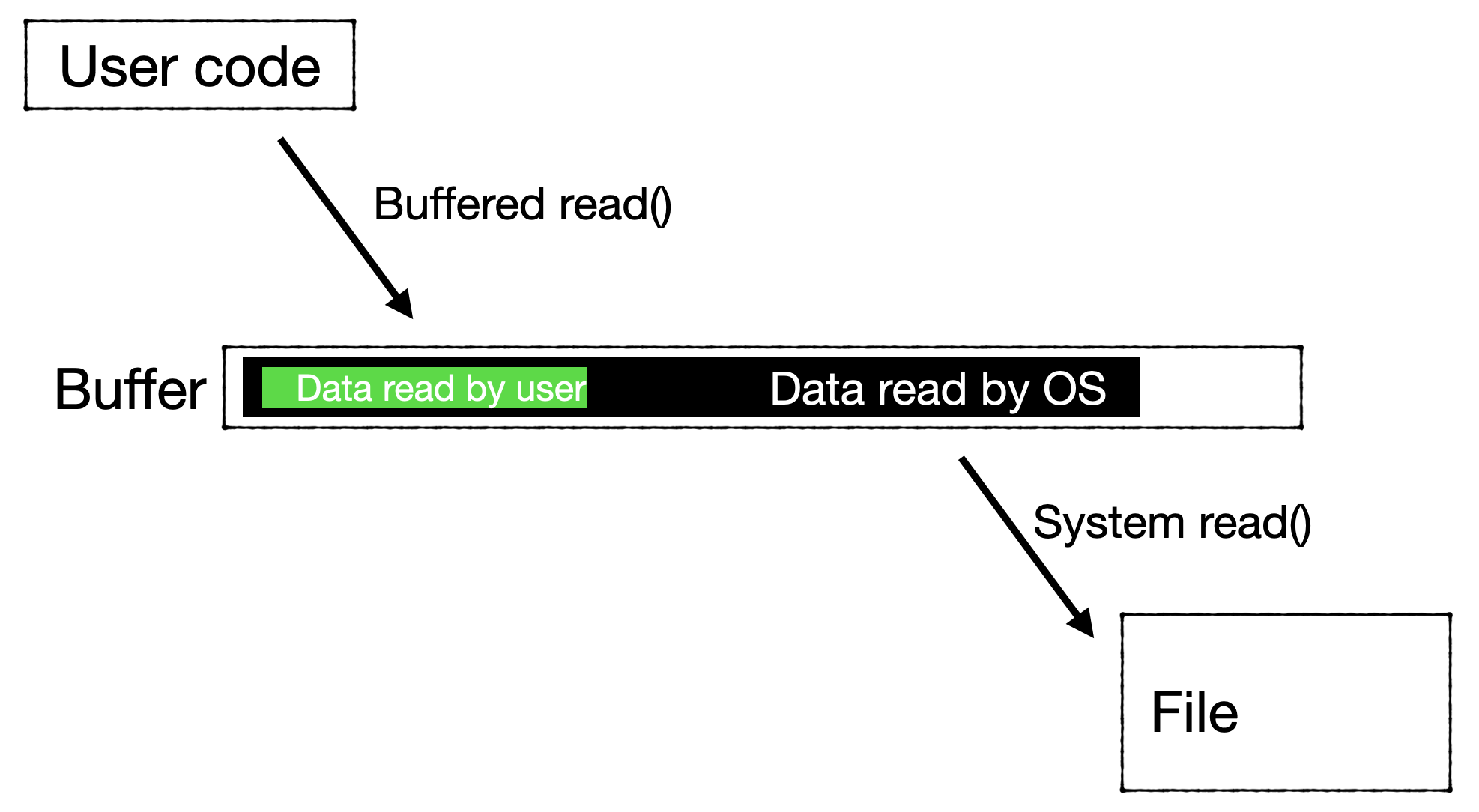
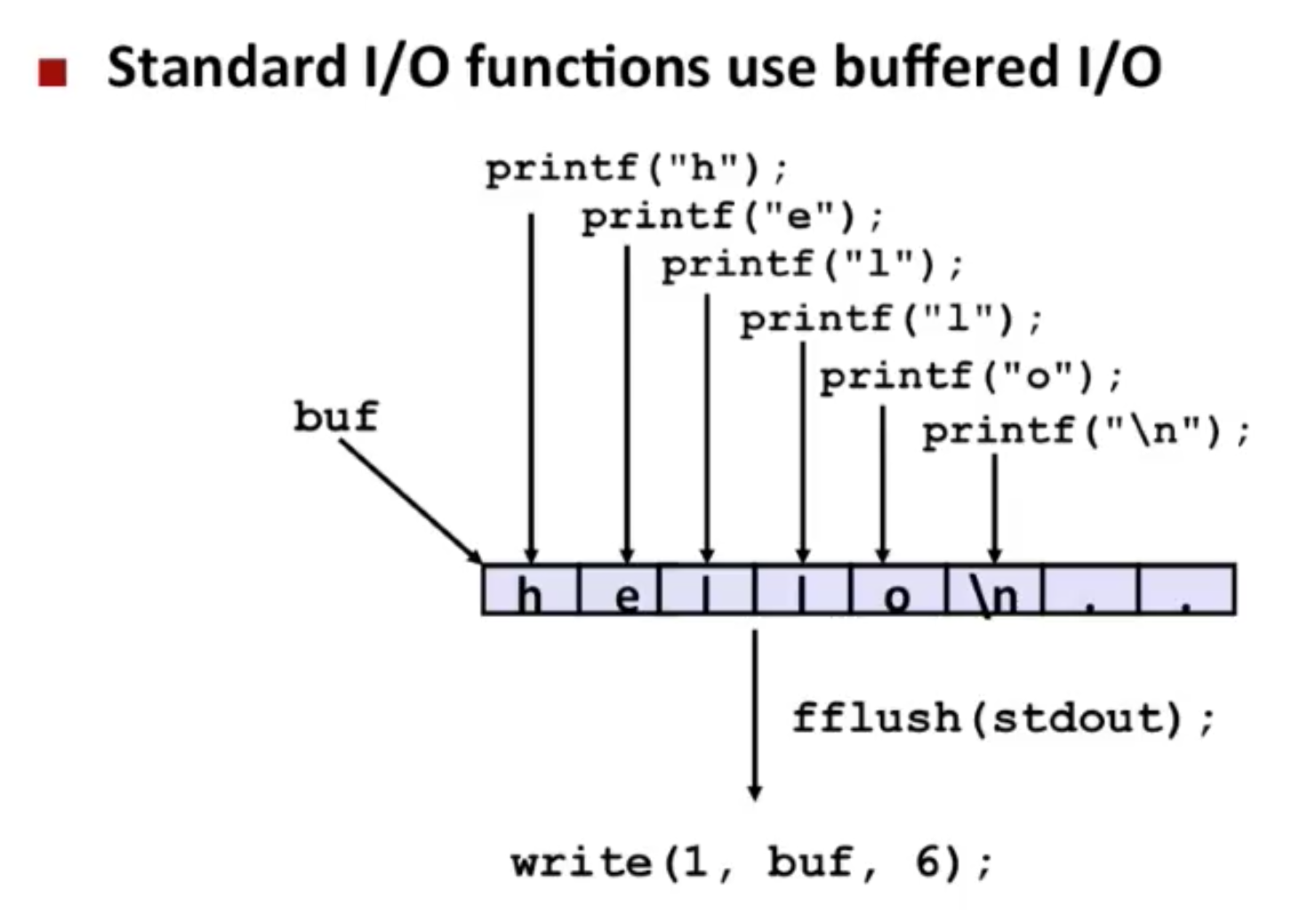
For example
1 |
|
1 | $ strace -e trace=write ./p |
Implementation
1 |
|
10.6 Reading File Metadata
An application can retrieve information about a file (sometimes called the file’s metadata) by calling the stat and fstat functions.
1 |
|
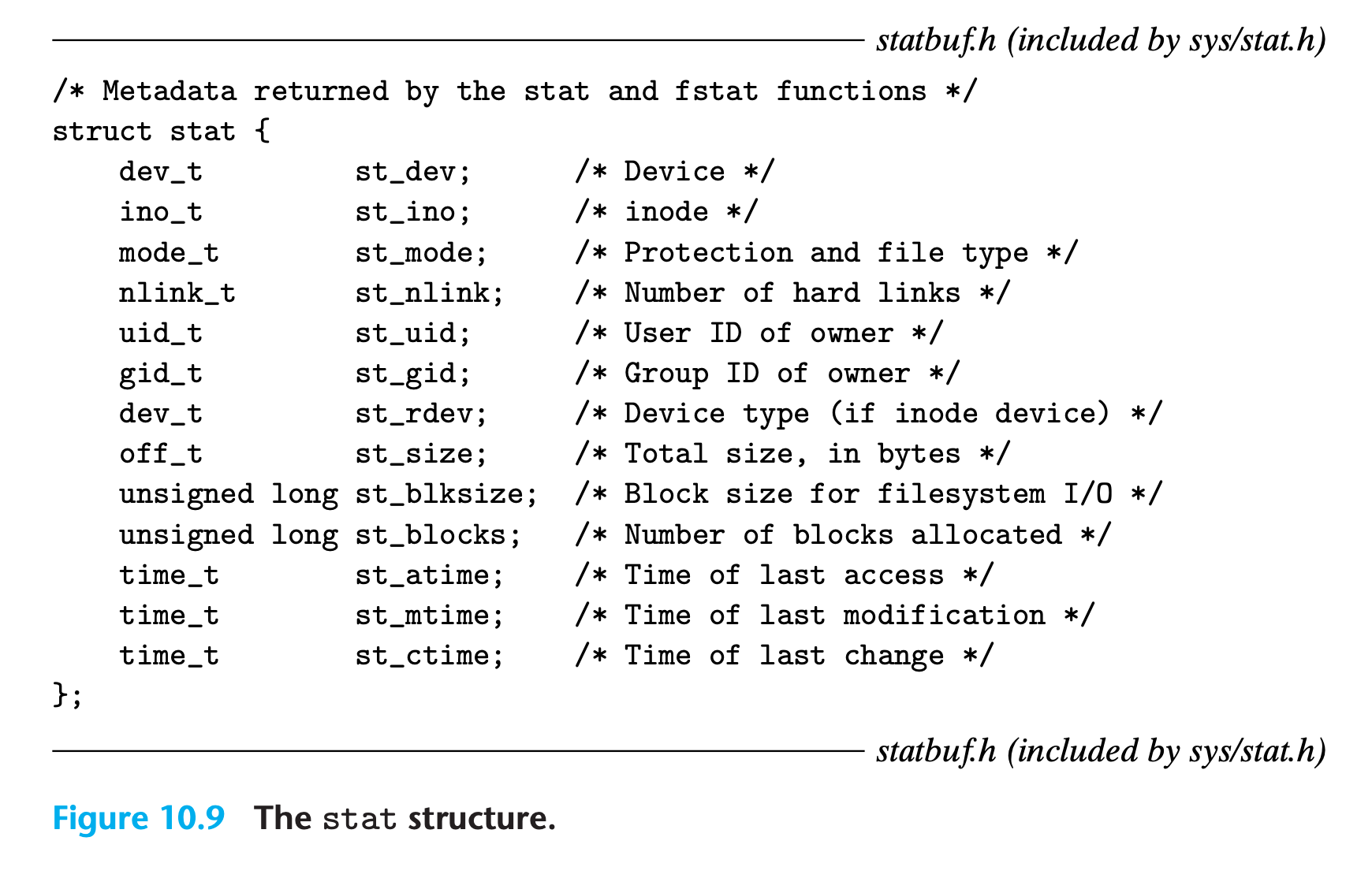
- The
statfunction takes as input a filename and fills in the members of a stat structure shown in Figure 10.9. - The fstat function is similar, but it takes a file descriptor instead of a filename
10.7 Reading Directory Contents
Applications can read the contents of a directory with the readdir family of functions.
1 |
|
The opendir function takes a pathname and returns a pointer to a directory stream. A stream is an abstraction for an ordered list of items, in this case a list of directory entries
1 |
|
On error, readdir returns NULL and sets errno. Unfortunately, the only way to distinguish an error from the end-of-stream condition is to check if errno has been modified since the call to readdir.
1 |
|
10.8 Sharing Files
Linux files can be shared in a number of different ways. The kernel represents open files using three related data structures:
- Descriptor table.
- Each process has its own separate descriptor table whose entries are indexed by the process’s open file descriptors.
- Each open descriptor entry points to an entry in the file table.
- File table
- The set of open files is represented by a file table that is shared by all processes
- Each file table entry consists of (for our purposes) the current file position, a reference count of the number of descriptor entries that currently point to it, and a pointer to an entry in the v-node table
- Closing a descriptor decrements the reference count in the associated file table entry.
- The kernel will not delete the file table entry until its reference count is zero.
- v-node table
- Like the file table, the v-node table is shared by all processes
- Each entry contains most of the information in the stat structure
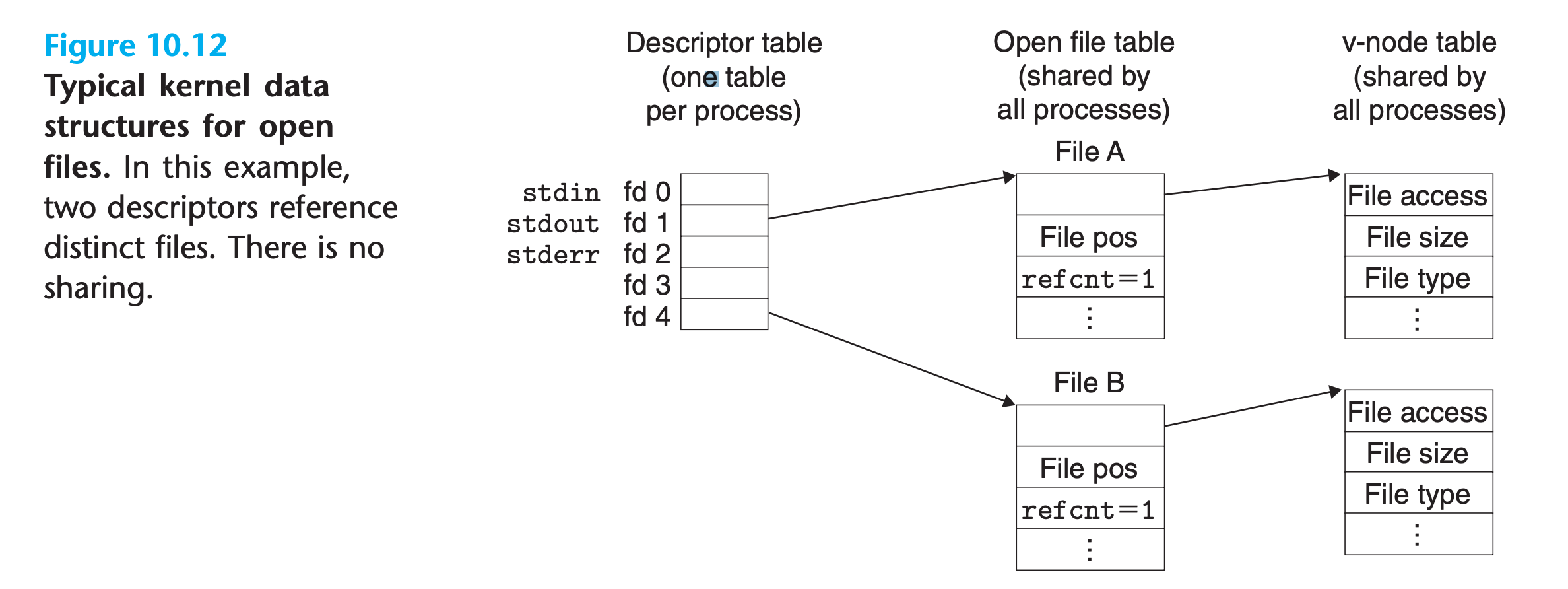
Multiple descriptors can also reference the same file through different file table entries, as shown in Figure 10.13
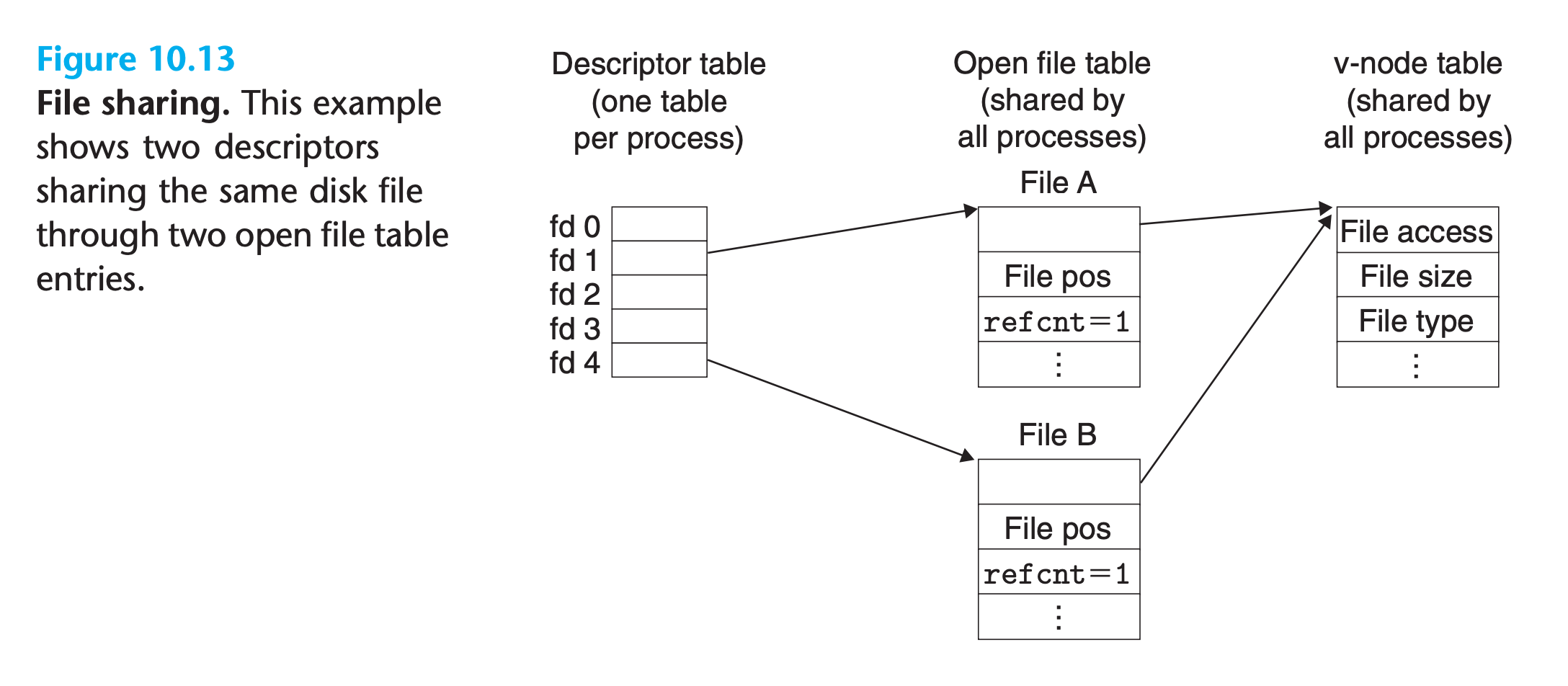
This might happen, for example, if you were to call the open function twice with the same filename.
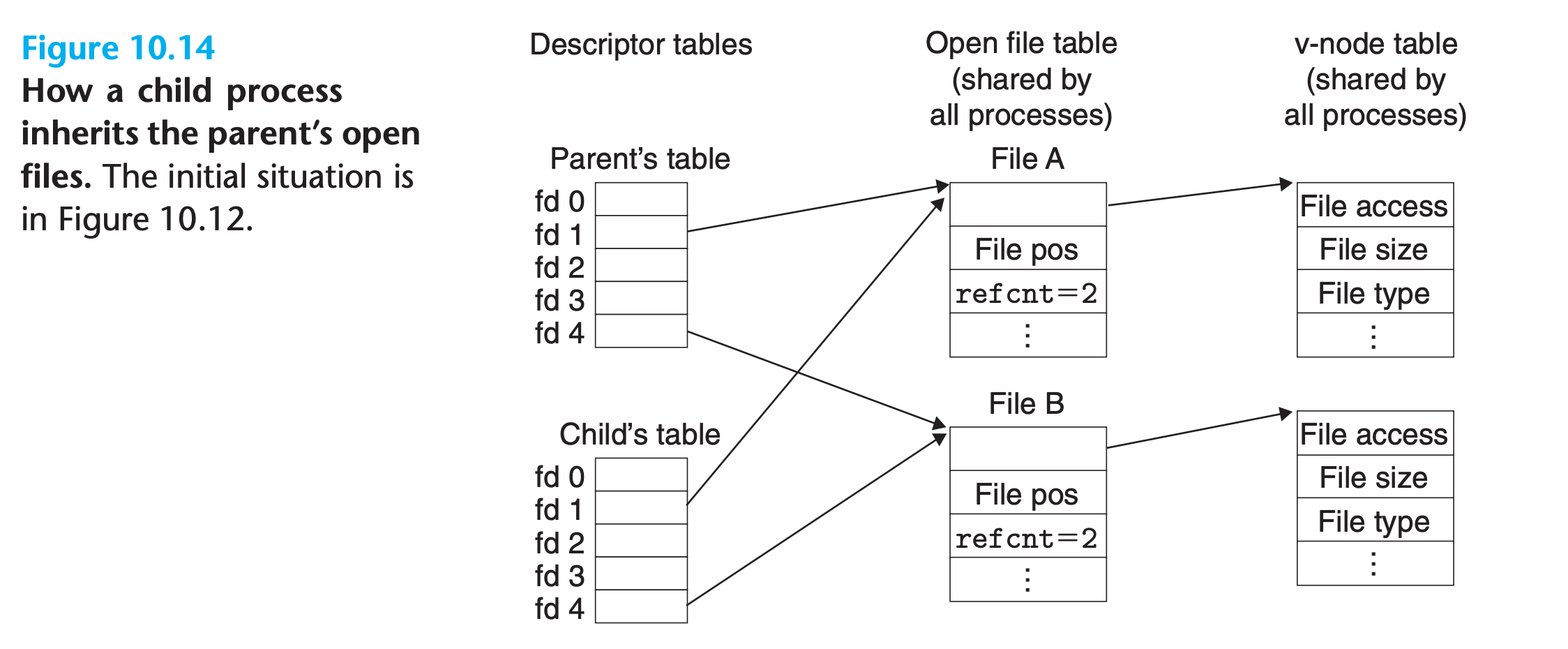
Practice Problem 10.2
Suppose the disk file
foobar.txtconsists of the six ASCII characters “foobar”. Then what is the output of the following program?
2
3
4
5
6
7
8
9
10
11
12
13
14
15
16
17
int main(){
int fd1 , fd2 ;
char c ;
fd1 = open("foobar.txt", O_RDONLY , 0);
fd2 = open("foobar.txt", O_RDONLY , 0);
read(fd1, &c, 1);
read(fd2, &c, 1);
printf("c = %c\n", c);
return 0;
}
Verification:
Since file position is stored in file table, both fd1 and fd2 will read from the beginning.
1 | c = f |
Practice Problem 10.3
As before, suppose the disk file foobar.txt consists of the six ASCII characters foobar. Then what is the output of the following program?
2
3
4
5
6
7
8
9
10
11
12
13
14
15
16
17
18
19
20
21
22
23
int main(){
int fd ;
char c ;
fd = open("foobar.txt", O_RDONLY , 0);
if ( fork() == 0){
read(fd, &c, 1);
exit(0);
}
wait(NULL);
read(fd, &c, 1);
printf("c = %c\n" , c);
exit(0);
}
My solution : :white_check_mark:
1 | c = o |
Because the child process shared the same file table with parent
10.9 I/O Redirection
Linux shells provide I/O redirection operators that allow users to associate standard input and output with disk files.
So how does I/O redirection work? One way is to use the dup2 function
1 |
|
The dup2 function copies descriptor table entry oldfd to descriptor table entry newfd, overwriting the previous contents of descriptor table entry newfd. If newfd was already open, then dup2 closes newfd before it copies oldfd.
For example , if dup2(4,1)
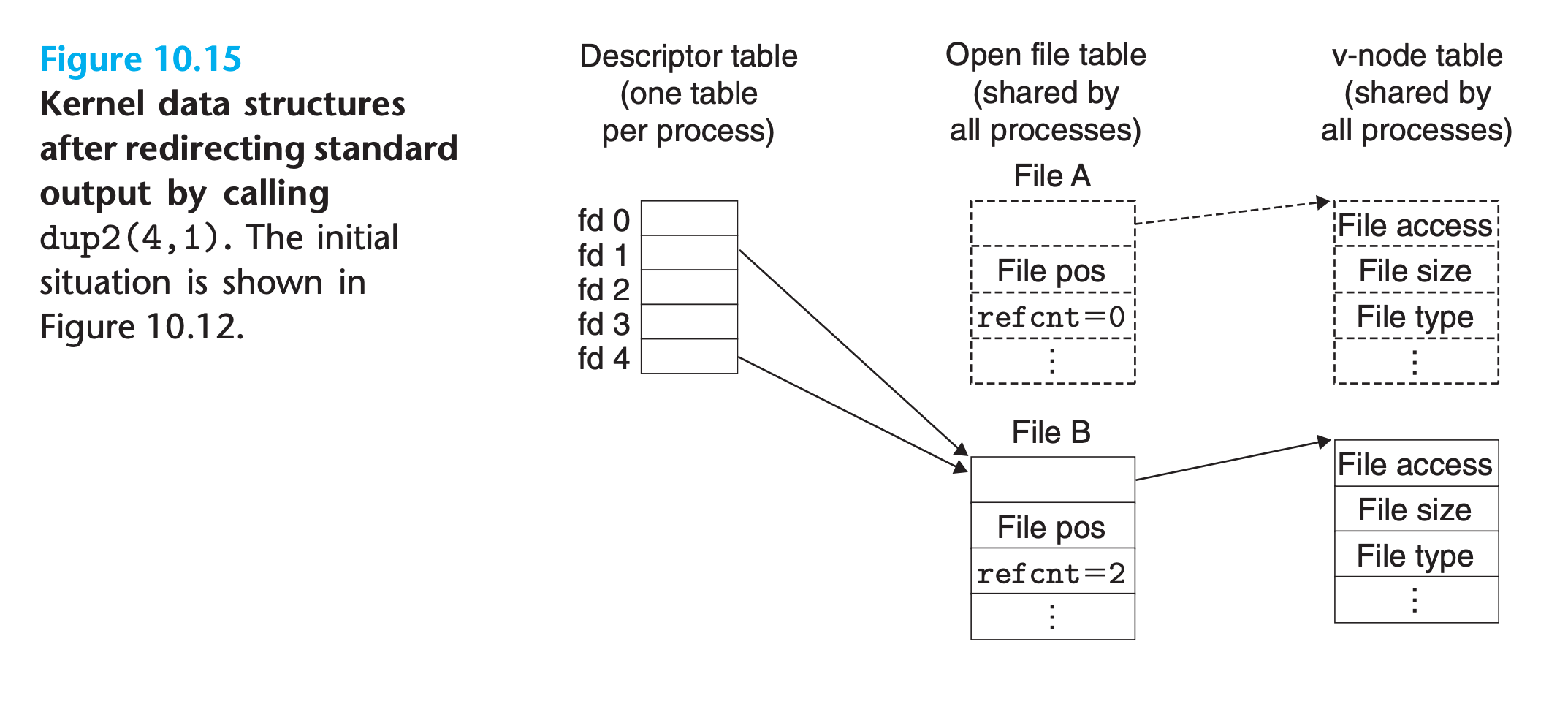
File A doesn’t exist
Practice Problem 10.5
Assuming that the disk file foobar.txt consists of the six ASCII characters foobar, what is the output of the following program?
2
3
4
5
6
7
8
9
10
11
12
13
14
15
16
17
18
19
20
int main(){
int fd1 , fd2 ;
char c ;
fd1 = open("foobar.txt", O_RDONLY, 0);
fd2 = open("foobar.txt", O_RDONLY, 0);
read(fd2, &c, 1);
dup2(fd2, fd1);
read(fd1, &c, 1);
printf("c = %c\n" , c);
exit(0);
}
My solution : :white_check_mark:
1 | c = o |
10.10 Standard I/O
A stream of type FILE is an abstraction for a file descriptor and a stream buffer. The purpose of the stream buffer is the same as the Rio read buffer: to minimize the number of expensive Linux I/O system calls
10.11 Putting It Together: Which I/O Functions Should I Use?

G1: Use the standard I/O functions whenever possible
G2: Don’t use
scanforrio_readlinebto read binary filesFunctions like scanf and rio_readlineb are designed specifically for reading text files
binary files might be littered with many 0xa bytes that have nothing to do with terminating text lines.
G3: Use the Rio functions for I/O on network sockets.